OSAC In Action
OSAC Adds Two New Standards to the Registry
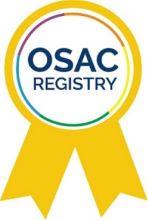
On June 18, 2019, the OSAC Forensic Science Standards Board (FSSB) approved the addition of two standards for listing on the OSAC Registry:
- ISO/IEC 17025:2017 General requirements for the competence of testing and calibration laboratories (from an OSAC Interdisciplinary Virtual Subcommittee, June 18, 2019). This document contains requirements for laboratories to enable them to demonstrate they operate competently and can generate valid results, thereby promoting confidence in their work. Many forensic science laboratories are accredited under the 2005 version of this standard and are progressing to meet the updated requirements in the 2017 version. As such, the 2005 version of this standard will also remain on the OSAC Registry through December 2020 to accommodate those laboratories making the transition to the 2017 version. OSAC supports this transition to meeting the requirements of the updated standard. In addition to laboratories, this standard is also useful to universities, research centers, government agencies, regulators, inspection bodies, and conformity assessment bodies with the need to do testing, sampling, or calibration.
- ANSI/ASB Standard 017, Standard Practices for Measurement Traceability in Forensic Toxicology, First Edition, 2018 (from the OSAC Toxicology Subcommittee, June 18, 2019). This standard defines the minimum requirements for establishing measurement traceability in forensic toxicology laboratories. This is the first forensic toxicology standard to be placed on the OSAC Registry. The OSAC Toxicology Subcommittee is championing many more standards through both the standards development process and the OSAC Registry Approval process to continue to enhance the discipline.
The OSAC Registry, which now contains 17 documents, serves as a trusted repository of high-quality, science-based standards and guidelines for the practice of forensic science. To be placed on the Registry, a standard or guideline must have been developed using a consensus-based process and passed the OSAC technical merit review by forensic practitioners, academic researchers, statisticians, and measurement scientists. OSAC encourages the adoption of standards listed on the OSAC Registry by all relevant agencies and practitioners.
For a complete list of the OSAC Registry Approved Standards and the standards under consideration, please visit the OSAC website.
OSAC and the American Bar Association
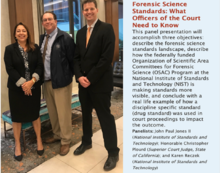
On May 29-30, OSAC Program Office staff and members participated in a panel at the American Bar Association’s Tenth Annual Prescription for Criminal Justice Forensic Science event in New York. Panelists described the current forensic science standards landscape, how OSAC is making standards more visible and shared a real-life example of how a drug standard was used in court proceedings to impact the outcome. OSAC recognizes that Officers of the Court are a key stakeholder group in the criminal justice system and plans to increase their engagement with them with directed outreach in 2020.
OSAC at the 2019 ASCLD Symposium

OSAC attended the 2019 American Society of Crime Laboratory Directors (ASCLD) Symposium held May 19-23 in St. Louis, Missouri. Before the Symposium, OSAC’s Program Office met with the U.S. Department of Justice’s Forensic Laboratory Needs Technology Working Group (FLN-TWG) to discuss implementation of OSAC standards by crime labs across the country and share several updates on the future of OSAC 2.0. The 2019 ASCLD Symposium meeting theme was "Embracing Change: Honor the Past, Engage the Present, and Prepare for the Future" and featured presentations on change management, implementing new technologies in DNA and Firearms analysis, and accreditation of digital evidence units. Many of these activities within the crime laboratory benefit by having standardized terminology, training parameters, and test methods to support bringing new technologies online faster and providing a foundation for technical leaders and quality assurance managers to build from as they improve their operations. OSAC’s engagement with the crime laboratory director community is critical for encouraging adoption of the OSAC supported standards and enabling scientists' participation in the development of new standards. OSAC is looking forward to the ASCLD 2020 symposium in Denver, Colorado.
OSAC at the Texas Commissioners Meeting

OSAC Program Office News
Calling All Forensic Science Experts

The success of OSAC’s efforts to facilitate the development of technically sound forensic science standards and promote the adoption of those standards by the forensic science community depends on your participation. OSAC is currently seeking to fill member vacancies on its committees and subcommittees due to a number of membership terms that will be expiring this September.
If you are one of the over 550 current members and are interested in seeking a second term, you will be considered for the vacancy. If you have previously applied, you do not have to submit a new application unless your contact information or other answers have changed since your original submission.
If you are interested in becoming a member of OSAC and have not previously applied, please complete and submit an application form in order to be eligible and considered for the positions opening in October.
Please contact OSAC Project Manager, Donna Kimball (donna.kimball [at] nist.gov (donna[dot]kimball[at]nist[dot]gov)) for more information.
Sharon B. Nakich Award - OSAC's New Annual Peer-to-Peer Award

In honor of our colleague, Sharon Nakich, who passed away in March after a short battle with cancer, the Awards Task Group of the FSSB has developed a new peer-to-peer award that will be given annually to recognize an individual who has made significant contributions to promote OSAC’s mission through his/her support of OSAC. To pay tribute to Sharon’s contributions to OSAC and continue her legacy, this award acknowledges a helpful attitude, kindness, teamwork or behind-the-scenes contributions to support the goals of the OSAC. All OSAC members and affiliates, OSAC Program Office staff, and any non-OSAC member who has contributed significantly to furthering the mission of OSAC is eligible to receive this award. The inaugural Sharon B. Nakich award will be presented in July at the OSAC All-Hands Meetings in Orlando, Florida.
OSAC Welcomes New Staff Members

OSAC 2.0 Updates
By Karen Reczek, NIST Ex-Officio, Forensic Science Standards Board (FSSB)
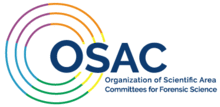
Since the launch of OSAC in the Fall of 2014, NIST’s long term goal has always been to transition OSAC to another outside entity. I know the forensic community is anxious to hear about NIST’s plan for OSAC 2.0.
In 2018, NIST recognized that we needed to start thinking about next steps. In the summer of 2018, we sent out a request for information, asking for input on the next iteration of OSAC. We received over 100 comments from this request and formed an internal team which spent many months developing new concepts. We presented these concepts to the FSSB in June of 2018 and to several professional societies from June through October 2018.
NIST took the feedback we received seriously and listened to the concerns with the concepts presented. The NIST team recently reconvened and through the past several months worked to develop a new plan. Here are some of the highlights:
- Our efforts to identify a new home for OSAC have not been successful. As such, NIST will continue to look for a suitable and sustainable place (which we have we have dubbed “OSAC 3.0”).
- OSAC 2.0 will remain at NIST.
- OSAC will remain as a single organization as we believe this is the best course forward to continue to stimulate collaboration among the various disciplines and leverage expertise.
- The FSSB will be focused on strategy and priorities, building on the Organizational Priorities Document work and the Standardization Roadmap Analysis work already started.
- Other changes include:
- Restructuring and “right-sizing” the SACs, with the Resource Committees being integrated into those efforts to provide input earlier in the development process;
- Implementing a different process for methods/results & conclusion standards vs. training, reporting, and terminology standards;
- Establishing an OSAC Internal Technical Review Panels for documents that address scientific issues such as validation, test methods, etc. These Panels include OSAC members and affiliates outside of the subcommittee/task group that draft the document(s);
- Streamlining the OSAC Registry Approval Process; and
- Ensuring OSAC members participate in the SDO efforts to guide documents through the development process.
NIST presented these proposed changes to the FSSB during their June 2019 in-person meeting and the feedback received was very positive. There was significant dialogue and time was spent clarifying and discussing some outstanding questions. All agreed that the plan for OSAC 2.0 was well-formed and offers improvements.
An update on OSAC 2.0 was also given at the OSAC Public Update Meeting held on June 5, 2019 on the NIST campus.
The projected timeline moving forward includes:
- Reviewing the timeline for implementation with the OSAC membership at the July 2019 All-Hands Meetings;
- Providing a high-level update to other forensic professional societies and stakeholders, as requested;
- In consultation with the FSSB, developing details surrounding the remaining changes, reviewing final plans for OSAC’s new structure, processes and other changes throughout 2019 (some of which will be implemented in October 2019); and
- Implementing the new 2.0 organization with new roles/assignments in place by October 1, 2020.
OSAC Public Update and Open Discussions Meeting
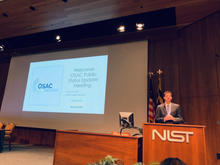
On June 5, 2019, more than 300 people joined us via webcast and in-person at the NIST campus in Gaithersburg for the OSAC Public Update and Discussion Meeting. Representatives from OSAC’s FSSB, SACs, three Resource Committees (RCs), and the Statistics Task Group shared updates on their activities and the latest forensic science standards under development. Presenters also identified research gaps, challenges being addressed and priorities for the year. If you couldn’t join us, you can view a video of the event and review the slide presentations which will be available on the OSAC website soon.
Scientific Area Committees (SAC) & Resource Committee (RC) Updates
Biology/DNA SAC
By Robin Ragsdale, Ph.D., SAC Chair
The Biology/DNA SAC provides strategic direction within the biology discipline, serves as a platform to integrate similar standards activities across multiple forensic science disciplines, and manages the activities of the following three subcommittees:
- Biological Methods
- Biological Data Interpretation and Reporting
- Wildlife Forensics
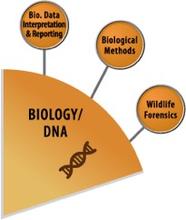
The Biology/DNA SAC members work closely with the subcommittees and various task groups to identify needed standards, develop new standards, as well as identify research needs for the forensic biology community. The Biology/DNA SAC works closely with SWGDAM to ensure efforts are complemented.
The Biological Methods Subcommittee is in the process of drafting two training documents, three serology and Y-STR documents, six validation documents, two sequencing documents and one familial searching document. Additionally, they have sent six training documents, three serology documents, three validation documents, and one contamination prevention document to the AAFS Standards Board (ASB) for further development.
The Biological Data Interpretation and Reporting Subcommittee is in the process of drafting three data analysis documents, three interpretation documents, three statistical analysis documents, four report writing documents, two CODIS documents and three testimony documents. Additionally, they have sent five other documents related to likelihood ratios, forensic DNA software and probabilistic genotyping systems validation, and internal self-evaluation of mixtures to ASB for further development. This subcommittee has had one standard published by ASB, which is now also moving through the OSAC Registry Approval Process.
The Wildlife Forensics Subcommittee has nine documents being drafted and two others that are being developed at ASB. ASB has also recently published six standards that were introduced by the Wildlife Forensics Subcommittee, all of which are currently moving through the OSAC Registry Approval Process.
Chemistry/Instrumental Analysis SAC
By Jose Almirall, Ph.D., SAC Chair
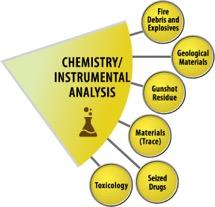
The primary responsibility of the Chemistry/Instrumental Analysis SAC is to evaluate the scientific foundations of all standards before these can be recommended to the OSAC Registry and to approve the list of published research needs for the different chemistry disciplines. The Chemistry/Instrumental Analysis SAC is comprised of six subcommittees that evaluate documentary standards and work with ASTM and ASB to develop new standards within the forensic chemistry disciplines.
As of this writing, 11 documents from the following subcommittees have been through ASTM’s standard development process and published:
- Fire Debris and Explosives – two documents published
- Gunshot Residue – one document published
- Materials (Trace) – five documents published
- Seized Drugs – two documents published
The Toxicology Subcommittee uses ASB as their SDO and has had two documents advance through the development process and be published by ASB.
In addition to the standards that have been published, there are 19 documents moving through the ASTM development process, 11 documents moving through the ASB development process, and 45 documents being drafted by the various Chemistry/Instrumental Analysis Subcommittees, including the Geological Materials Subcommittee.
This SAC now has eight standards listed on the OSAC Registry with one other moving through the OSAC Registry Approval Process.
While ASTM and ASB continue to revise drafts submitted by the OSAC, the Chemistry/Instrumental Analysis SAC will continue to work on other documents in the areas of training, test methods, reporting, and testimony. In addition to drafting standards and best practice recommendations, the SAC has also been working on roadmaps and identifying research needs.
Crime Scene/Death Investigation SAC
By Gregory Davis, M.D., SAC Chair
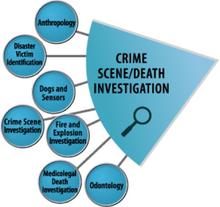
The Crime Scene/Death Investigation (CS/DI) SAC seeks to improve forensic practice by creating and promoting standard guidelines and protocols to ensure that the results of forensic analysis are reliable and reproducible, from the time of gathering evidence to interpretation of evidence. To this end, the SAC now has four standards on the OSAC Registry with two more nearly through the OSAC Registry Approval Process. Another 14 standards developed by the CS/DI SAC Subcommittees are with SDOs for review, comment, and approval, and 45 standards are in development within the subcommittees. Highlights for each of the seven CS/DI SAC Subcommittees are below.
The Anthropology Subcommittee has three documents at ASB concerning facial approximation, sex estimation, and stature estimation. Standards under development include standards for estimation of ancestry and age and for identifying pathological conditions and bony anomalies. Other standards in development pertain to detecting and processing scenes where potential human remains are discovered, whether as a single individual or commingled remains.
The Crime Scene Investigation (CSI) Subcommittee has one document at ASTM concerning the standard practice for crime scene investigator training, continuing education, professional development, certification, and accreditation. CSI is also guiding six existing ASTM standards concerning standard methods for collecting and labeling physical evidence, evaluating data, and reporting opinions through the OSAC Registry Approval process. Additionally, CSI is writing standards related to crime scene reconstruction and preservation of biological evidence and seized drugs.
The Disaster Victim Identification (DVI) Subcommittee has two standards nearly through the OSAC Registry Approval Process. These standards describe strategies for comprehensive searches of automated fingerprint identification system databases and best practices for anthropology in the setting of a disaster. DVI has four standards at ASB related to data management, scene processing, fingerprint recovery, and dental identification. Standards under development include aspects of best practices in preparing for and managing a mass fatality scene (i.e., including relatives of decedents and communication with media representatives), safe practices for responders (e.g., both from exposure to dangerous substances at the scene and from the psychological effect of working a mass fatality scene), and quality assurance.
The Dogs and Sensors Subcommittee has over 20 standards they have been developing, all of which are based on two standards describing terms and definitions and general guidelines. Accordingly, these two documents will serve as a foundation for the others. Once these foundational standards are approved, the other documents will begin working their way through the standards development process, including documents describing the selection of handlers and dogs, career field progression, kenneling, presenting evidence in court, and the application of dogs’ special abilities in specific circumstances (e.g., detecting accelerants, explosives, human rescue, human remains, illicit drugs, etc.).
The Fire and Explosion Investigation Subcommittee has two standards on the OSAC Registry. The first is the comprehensive guide (i.e., book) for fire and explosion investigation. The second standard on the OSAC Registry describes professional qualifications for fire investigators. As is their custom, Fire and Explosion is now tackling the broad topic of the organization and operation of Fire Investigation Units, a work that will address “the unit” similar to the way the existing standard addresses professional qualifications for fire investigators. This subcommittee is also working on a strategic plan for the future of fire and explosion investigation.
The Medicolegal Death Investigation (MDI) Subcommittee has one standard at an SDO which is intended to be an organizational and foundational standard for medicolegal death investigation, from scene investigation to examination of a body by a pathologist to death certification. MDI is also developing a standard for capturing common data elements from death investigation in a way that will make it possible to share these data with appropriate agencies, such as local or state public health departments, the Centers for Disease Control and Prevention, and other agencies that need the unique data generated by medicolegal death investigation to prevent future unnecessary deaths.
The Odontology Subcommittee has two standards on the OSAC Registry. The first involves the forensic dental data set, and the second describes human identification. Two other documents, one involving age estimation from dental assessment, and the other describing standard terminology, are currently at an SDO. Standards under development include bitemark analysis, comparison, and reporting and recognition of abuse by dental professionals.
Digital/Multimedia SAC
By Richard Vorder Bruegge, Ph.D., SAC Chair
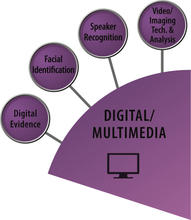
The Digital/Multimedia SAC is comprised of the following four subcommittees that are very active in the development and evaluation of documentary standards:
- Digital Evidence
- Facial Identification
- Speaker Recognition
- Video Imaging Technology/Analysis
The Digital Evidence Subcommittee is in the process of drafting six documents and has five documents under development at ASTM related to training and education, preservation, collection and acquisition, analysis, quality assurance, and reporting and testimony.
The Facial Identification Subcommittee has one standard guide on the OSAC Registry which describes a facial image comparison list for morphological analysis. Two other documents from this subcommittee are currently in the OSAC Registry Approval Process, and eleven others are under development.
The Speaker Recognition Subcommittee is in the process of drafting six documents and have two documents under development with ASTM.
The Video Imaging Technology/Analysis (VITAL) Subcommittee has a standard guide for forensic digital imaging processing that is currently in the OSAC Registry Approval Process. Three other documents are at ASTM for development and four other documents are being drafted by the subcommittee.
In addition to drafting standards and best practice recommendations, the SAC has also been working on roadmaps and identifying research needs.
Physics/Pattern Interpretation SAC
By Melissa Gische, SAC Chair
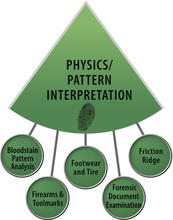
The primary responsibilities of the Physics/Pattern Interpretation Scientific Area Committee (PSAC) are to provide direction and oversight for, and to review and approve standards, best practice recommendations, and technical reports for the following five subcommittees:
- Bloodstain Pattern Analysis (BPA)
- Firearms and Toolmarks (FATM)
- Forensic Document Examination (FDE)
- Friction Ridge (FR)
- Footwear and Tire (FWT)
As a result, the PSAC has been working on both roadmap and framework documents to outline a path forward.
The PSAC subcommittees (SCs) use ASB as the SDO for completed documents. The ASB has three types of documents: Standard (STD), Best Practice Recommendation (BPR), and Technical Report (TR).
As of this writing, the Bloodstain Pattern Analysis Subcommittee has had two documents complete the ASB process and be published by ANSI/ASB:
- ANSI/ASB Technical Report 033, Terms and Definitions in Bloodstain Pattern Analysis, First Edition, 2017
- ANSI/ASB Standard 072, Standard for the Validation of Procedures in Bloodstain Pattern Analysis, First Edition, 2019
Two other PSAC subcommittees have ASB draft documents open for comment:
- FR: ASB Best Practice Recommendation 012, Best Practice Recommendation for Articulating a Source Identification in Friction Ridge Examinations, First Edition (comment deadline, July 8, 2019)
- FATM: ASB Best Practice Recommendation 068, Safe Handling of Firearms and Ammunition, First Edition (comment deadline, July 8, 2019)
Other PSAC SC works in progress at ASB include examination methods (FATM, FDE), report writing (BPA), training and education (BPA, FATM, FR, FWT), quality assurance (BPA), conclusions (FATM, FR), and terminology (FDE, FWT).
While the ASB consensus bodies continue to revise drafts submitted by the OSAC, the PSAC SCs continue to work on other documents in the areas of certification, documentation, proficiency testing, reporting, test methods, examination, training, and conclusions. In addition to drafting standards and best practice recommendations, the PSAC SCs have also been working on roadmaps and research needs.
Human Factors Committee
By William Thompson, J.D., Ph.D., HFC Chair
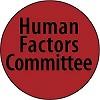
The mission of OSAC’s Human Factors Committee (HFC) is to serve as a resource to OSAC members on issues related to human factors. To support its mission, the HFC provides guidance on the influence of systems design on human performance and on ways to minimize cognitive and confirmation bias and mitigate errors in complex tasks. The nine members of the OSAC HFC continue to work together to fulfill their roles and responsibilities, which include:
- Working with relevant SACs and subcommittees on discipline specific human factors issues
- Providing feedback and recommendations on human factors issues during the development of draft standards
- Producing internal guidance documents that support OSAC standards development work
- Preparing human factor impact statements (i.e., subjectivity in decision making, error magnets, cognitive load, error identification and mitigation) for draft standards submitted for review
- Providing feedback on the development of forensic science laboratory case notes and report templates, as appropriate
Other areas of interest the HFC is currently focusing on include assessing and improving examiner performance, improving communication with lay audiences, forensic ergonomics, and stress, fatigue and performance issues.
Legal Resource Committee
By Christopher Plourd, J.D., LRC Chair
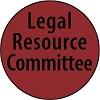
The OSAC Legal Resource Committee (LRC), with its diverse membership, supports OSAC subcommittees and task groups with legal issues relating to the development and finalization of high-quality forensic science standards. The LRC’s 11 members, including three Judicial members, have also focused on assisting the OSAC subcommittees by taking the lead on a recently approved FSSB virtual subcommittee to develop a standard for minimum legal education requirements for forensic practitioners. This document will describe legal issues in which forensic examiners who conduct analyses relevant to criminal prosecutions should be aware of and is being prepared by the OSAC LRC for the benefit of all forensic examiners. The document will begin with the gathering of evidence and will address testing, evidence preservation, and documentation. It will then describe the pre-trial disclosure of information, including what is called the Brady rule, the obligation of the prosecution and agencies working with the prosecution to provide information helpful to the accused; subpoenas and other requests for documents or testimony; and the relationship of the expert to both the lawyer calling that expert and opposing counsel. The final portion will cover rules of evidence related to expert testimony presented at per-trial hearings and trials. The document will represent the consensus view of LRC and will be the draft for consideration by an OSAC-wide virtual subcommittee.
Another focus of the LRC is commenting on a reoccurring issue in the development of OSAC standards regarding the use of the term “meaningful difference.” The LRC will continue to work with the SACs and SCs to review and better define this term.
Quality Infrastructure Committee
By Karin Athanas, QIC Chair
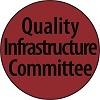
The OSAC Quality Infrastructure Committee (QIC) was formed in 2014 on a foundation of quality with a mission to act as a resource to OSAC members on quality issues, to interface with standards development organizations, accreditation bodies, and certification bodies, and to maintain the OSAC Registry and OSAC Catalog of related standards.
Since then, the QIC’s mission has expanded to include development and maintenance of the OSAC Lexicon of commonly used terms where the QIC is currently working in concert with all OSAC units to develop consensus on terms and how they are defined, these will be referred to as the ‘OSAC Preferred Terms.’ Thus far, the QIC has gained consensus on 6 terms including cognitive bias, confirmation bias, and contextual bias. Stay tuned in 2019 as we continue to gain consensus and publish additional terms and definitions. To review a full list of OSAC preferred terms, see the OSAC lexicon at lexicon.forensicosac.org.
Also related to the OSAC Lexicon, the OSAC QIC has developed an indexing process and will be working through 2019 with the OSAC units to update all terms and to develop procedures for the continued maintenance of the Lexicon. The QIC has also engaged with the OSAC Forensic Science Standards Board (FSSB) to assist in efforts to educate the public and forensic community of the ways the Lexicon and the OSAC Registry can be used and to encourage their use.
The QIC was an active participant in 2018 on the OSAC Virtual Subcommittee formed to review the ISO/IEC 17025:2017 standard that has recently been placed on the OSAC Registry.
In addition to the work above, the OSAC QIC continues to perform all duties assigned to our committee, including:
- Reviewing all documents in development at the OSAC, including those developed for submission to standards development organizations, and those moving through the OSAC registry approval process;
- Reviewing all comment adjudications to ensure process has been followed and comments adjudicated;
- Liaising with all OSAC SACs;
- Developing impact statements for each document moving through the Registry Approval Process; and,
- Continued work supporting the FSSB in maintaining the OSAC policies and procedures. In 2018 this included updates to the technical merit sheet and associated procedures and the OSAC SDO and Registry process maps.
OSAC In The News

Third Forensic Laboratory Voluntarily Adopts OSAC Standards
Press, R. (2019, Summer). Evidence Technology Magazine.Beyond CSI: How big data is reshaping the world of forensics
Melende, S. (2019, February). Fast Company. Retrieved from https://www.fastcompany.com/90306266/how-big-data-is-slowly-reshaping-t…Upcoming OSAC Events
 Credit:
Dafne Cholet Licensed by CC BY 2.0
JULY
Credit:
Dafne Cholet Licensed by CC BY 2.0
JULY

9-12 OSAC All-Hands Meeting, Orlando, FL (Chemistry/Instrumental Analysis SAC and Subcommittees, Crime Scene/Death Investigation SAC and Subcommittees, and Resource Committees)
23-26 OSAC All-Hands Meeting, Orlando, FL (Biology/DNA SAC and Subcommittees, Digital/Multimedia SAC and Subcommittees, Physics/Pattern Interpretation SAC and Subcommittees)
AUGUST
11-17 International Association for Identification Conference, Reno, NV (OSAC SAC and Subcommittees will be delivering eight presentations during the conference)
SEPTEMBER
17 OSAC Leadership Strategy Session, Tampa, FL
18-19 FSSB In-person Meeting, Tampa, FL
Professional Organization Spotlight
Association of Firearm and Tool Mark Examiners
By Mark Keisler, OSAC FSSB Vice Chair
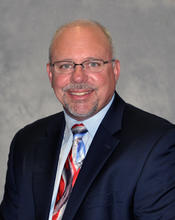
The Association of Firearm and Tool Mark Examiners (AFTE) is the international professional organization for practitioners of Firearm and/or Toolmark Identification and has been dedicated to the exchange of information, methods and best practices, and the furtherance of research since its creation in 1969. Beginning in 1998, members of AFTE were participants in the Scientific Working Group for Firearms and Toolmarks (SWGGUN) and collectively authored standards and guidelines for the discipline. Their work continued for 17 years until funding for this group dissipated. During the organization of the OSAC, AFTE was asked to participate in the formation and launch of this new project. Since then, members of AFTE have participated at all levels of the OSAC and in numerous subcommittees. More importantly, AFTE members have been diligently authoring standards for firearm and toolmark examinations and have been steering them through the OSAC and SDO process. Members of both the FSSB and the Firearm/Toolmark Subcommittee routinely report the progress of both the OSAC and the work of the subcommittee to the AFTE membership. This was last completed at the AFTE Training Seminar in Nashville in May 2019. AFTE’s partnership with the OSAC has been very beneficial and continues to strengthen the firearm and toolmark discipline. Research needs have been identified, gap analysis has been explored, and OSAC aided in the development of a detailed process map. As AFTE moves forward in its support of the OSAC, discussions on the implementation of OSAC Registry Standards will be forthcoming and anticipated.
On a personal note, as the AFTE representative on the FSSB, I must say I have enjoyed my time on the FSSB. I will be leaving in October due to term limits and will be exiting with a heavy heart. I have developed professional relationships with some of the brightest individuals in our community and this has made me a better person. Though no longer on the FSSB, I will support the OSAC in any way I can. I have openly stated that my Unit will be “self-adopting” firearm/toolmark standards that make it to the OSAC Registry. Also, I have routinely reported the work of the OSAC to my Unit and to members of the laboratory executive staff at quarterly meetings. Members of my laboratory sit at every level of the OSAC and it is my hope that this involvement continues. The work we are doing within the OSAC is historic and being watched world-wide. A very good friend of mine once said, “When the OSAC sneezes the world catches a cold”, and I truly believe this. Rest assured, what we are doing is monumental in our community and I anxiously await the outcomes produced by this prodigious organization.
NIST Activities

Save the date for the Evidence Management Conference that NIST and NIJ will be hosting on October 2-4, 2019 on the NIST campus in Gaithersburg, Maryland.

Forensic Science Research Innovation to Implementation (RI2I) Symposium
Read more about NIST’s RI2I Symposium, an event where forensic scientists, researchers, and technology transfer experts came together with laboratory professionals, business leaders and other stakeholders to explore ideas for speeding innovation in the nation’s crime labs.
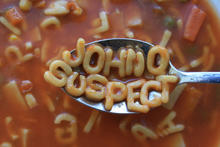
DNA Mixtures: A Forensic Science Explainer
Read more about DNA mixtures and why they are sometimes so difficult to interpret.

